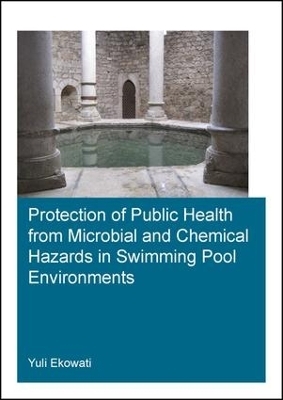
Protection of Public Health from Microbial and Chemical Hazards in Swimming Pool Environments
CRC Press (Verlag)
978-0-367-25135-2 (ISBN)
This thesis describes the occurrence of microbial and chemical contaminants in swimming pools and the investigation of an alternative disinfection technology, UVOX Redox® that could reduce reliance on chlorine and the formation of chlorinated disinfection byproducts (DBPs) in swimming pools. This technology was effective in inactivation of chlorine resistant microorganisms, represented by Bacillus subtilis spores, and in combination with chlorine generated lower concentrations of chlorinated DBPs compared to chlorination alone. It enhanced the removal of pharmaceuticals and personal care products (PPCPs), which were frequently present in indoor, outdoor and spa pools. Carbamazepine and 1H-benzotriazole were the most frequently detected PPCPs, while hydrochlorothiazide and 4-methylbenzylidene camphor were detected at the highest concentration. An investigation of seven different swimming pool facilities showed that clinically relevant fungi were omnipresent. Floors at the sites where the pool visitors converge, such as the exit leading to shower rooms, showed the highest fungal concentrations. The distribution of fungi inside the swimming pool facilities highlighted potential transmission pathways and a possible risk of fungal infections. Future swimming pool water guidance should include raising awareness among swimmers, pool operators and managers about hygienic behaviour and better hygiene measures, and application of alternative disinfection technologies such as UVOX.
Key features:
Identifies clinically relevant fungi in swimming pool environments
Identifies potential transmission pathways of clinically relevant fungi in indoor swimming pools
Highlights the occurrence of PPCPs in different type of pools and their relation with pool water treatment
Assesses an alternative disinfection technology for swimming pool water treatment.
Yuli Ekowati completed her MSc degree in Water Supply Engineering at IHE Delft in 2011. She became a research fellow in the Department of Environmental Engineering and Water Technology. During that time, she worked in several research topics related to membrane fouling, namely algal organic matter and synthetic polymer, and also in research on biological stability of drinking water. In 2014, she had the opportunity to continue as a PhD candidate in IHE Delft. Her PhD research focused on microbial and chemical contaminants in swimming pool environments and assessment of an alternative disinfection technology for swimming pools. The research was conducted in collaboration with Catalan Water Research Institute (ICRA), Westerdijk Institute and National Institute for Public Health and Environmental Protection (RIVM). She will be awarded with a PhD degree from Utrecht University in March 2019. She is interested in microbiological and chemical quality of water, water treatment technologies, particularly on pre-treatment, disinfection and membrane-based technologies, related to removal of micropollutants, formation of disinfection byproducts, and membrane fouling.
1 Introduction
2 Application of UVOX Redox® for swimming pool water treatment: microbial inactivation, disinfection byproduct formation and micropollutant removal
3 Occurrence of pharmaceuticals and UV filters in swimming pools and spas
4 Clinically relevant fungi in water and on surfaces in an indoor swimming pool facility
5 Potential transmission pathways of clinically relevant fungi in indoor swimming pool facilities
6 General discussion
| Erscheinungsdatum | 30.04.2019 |
|---|---|
| Reihe/Serie | IHE Delft PhD Thesis Series |
| Verlagsort | London |
| Sprache | englisch |
| Maße | 170 x 240 mm |
| Gewicht | 317 g |
| Themenwelt | Studium ► Querschnittsbereiche ► Prävention / Gesundheitsförderung |
| Naturwissenschaften ► Geowissenschaften ► Hydrologie / Ozeanografie | |
| Technik ► Umwelttechnik / Biotechnologie | |
| ISBN-10 | 0-367-25135-3 / 0367251353 |
| ISBN-13 | 978-0-367-25135-2 / 9780367251352 |
| Zustand | Neuware |
| Informationen gemäß Produktsicherheitsverordnung (GPSR) | |
| Haben Sie eine Frage zum Produkt? |
aus dem Bereich


